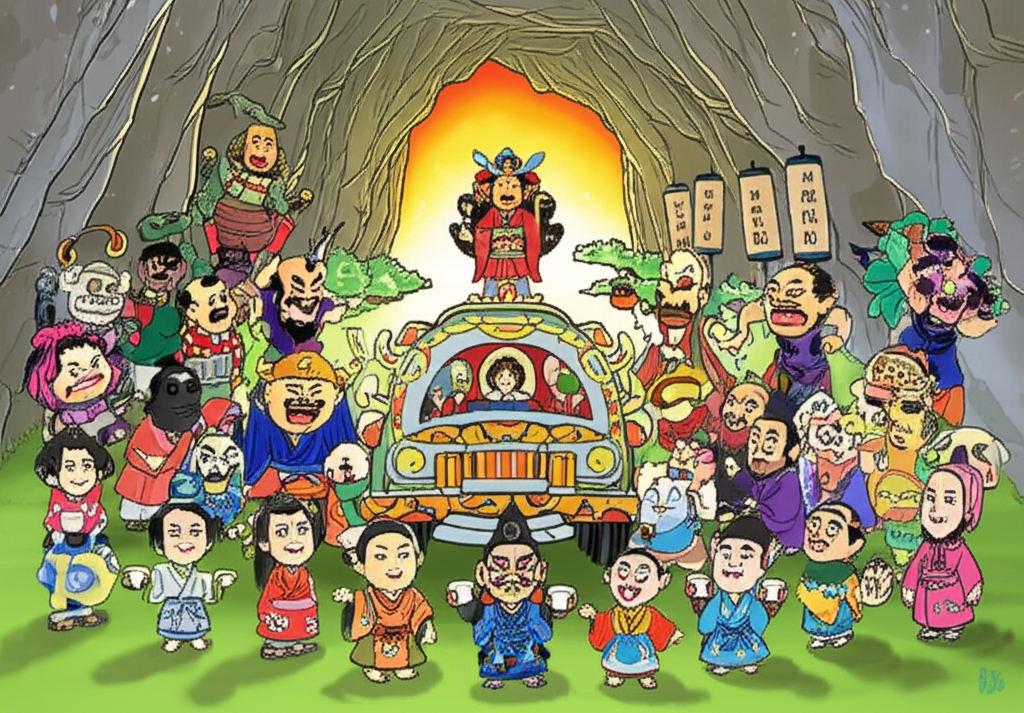
The mists of ancient Japan, woven with tales of kami and cosmic struggles, offer a rich tapestry of stories that have shaped its cultural identity for millennia. Among these narratives, the myth of Amaterasu, the sun goddess, and her dramatic retreat into a cave after a quarrel with her tempestuous brother Susano’o, resonates with particular power. This is not a record of historical events, but rather a traditional story, a product of the fertile imagination of ancient peoples seeking to explain the world around them, the cycles of nature, and the complex dynamics of power and family. The tale of Amaterasu’s Cave, and the subsequent events in the aftermath of her brother’s chaotic reign in Izumo, offers a fascinating glimpse into the worldview of early Japanese society.
The era in which these myths likely took root was one of nascent civilization, where the boundaries between the natural and the divine were blurred. Early Japanese communities, agrarian and deeply connected to the land, perceived the world as alive with spirits and forces. The sun’s warmth and light were essential for life, a benevolent power that governed the rhythm of the seasons. Conversely, storms, darkness, and unpredictable events were often attributed to the capricious actions of powerful beings. Their understanding of the cosmos was animistic, a belief system where natural phenomena were imbued with spiritual essence. Leadership, both within the community and in the mythical celestial realm, was a paramount concern, and the interactions between deities often mirrored human struggles for dominance, order, and reconciliation.
At the heart of this particular narrative is Amaterasu Ōmikami, a figure of immense significance. She is often depicted as a radiant, regal goddess, the embodiment of the sun itself. Her symbolic attributes are profound: she represents light, warmth, life-giving energy, and celestial authority. Her role as the supreme deity in the Shinto pantheon, and the mythical ancestress of the Japanese imperial line, highlights her importance as a symbol of order, purity, and cosmic governance. In contrast, her brother, Susano’o-no-Mikoto, is a figure of raw, untamed power. He embodies the wild, destructive forces of nature – storms, earthquakes, and the untamed sea. His symbolic attributes are those of chaos, impulsivity, and the darker, more unpredictable aspects of existence. The conflict between them is not merely a personal dispute, but a cosmic clash between order and chaos, light and darkness.
The tale unfolds after a series of provocative and destructive acts by Susano’o, culminating in his desecration of Amaterasu’s sacred rice fields and the throwing of a flayed horse into her weaving hall. Grief-stricken and overwhelmed by her brother’s relentless transgressions, Amaterasu, the very source of light and life, retreats into the Amano-Iwato, the celestial rock cave. This act plunges the world into an eternal night. The vibrant tapestry of existence fades into a chilling darkness, and the myriad of beings on earth despair. The world, dependent on her radiance, begins to wither and falter. This is the immediate aftermath of Izumo, where Susano’o’s reign of terror in the earthly realm directly impacts the celestial order and, by extension, the mortal world.
The other kami, witnessing the devastating consequences of Amaterasu’s absence, devise a plan to lure her out. They devise a grand festival outside the cave, filled with music, revelry, and a mirror that reflects the light of a smaller, more intimate lamp. The goddess Ame-no-Uzume, a figure of mirth and revelry, dances with such abandon and joy that the other kami erupt in laughter. Amaterasu, intrigued by the sounds of merriment and the distant gleam of light, peeks out of the cave. As she emerges, drawn by curiosity and the promise of renewed light, she is captivated by her own reflection in the mirror. The kami seize this moment of distraction, placing a sacred rope across the cave entrance, effectively barring her re-entry. Gradually, with the sun goddess back in her rightful place, light and warmth return to the world.
The symbolism embedded within this narrative is rich and multifaceted. Amaterasu’s retreat into the cave can be interpreted as representing periods of darkness, despair, or the withdrawal of benevolent influence that societies sometimes experience. Her return symbolizes renewal, the re-establishment of order, and the triumph of light over darkness. Susano’o’s destructive acts can be seen as representing the disruptive forces that challenge stability, whether they be natural disasters, social unrest, or internal conflict. The collective effort of the other kami to lure Amaterasu out highlights the importance of community, cooperation, and ingenuity in overcoming adversity. The mirror, reflecting the goddess’s own image, can symbolize self-awareness and the recognition of one’s own power and importance. The rope, a simple yet effective barrier, signifies the establishment of boundaries and the maintenance of order.
In the modern world, the myth of Amaterasu and her cave continues to resonate, finding expression in various forms of media and scholarly study. In literature, it serves as a foundational element in Japanese mythology anthologies and children’s stories, often adapted to introduce younger generations to their cultural heritage. Video games, particularly those set in fantastical Japanese landscapes or drawing inspiration from Shinto lore, frequently feature Amaterasu as a powerful protagonist or a significant deity, her connection to the sun and divine power a recurring theme. In cultural studies and comparative mythology, the story is analyzed for its insights into ancient Japanese cosmology, societal values, and the archetypal struggle between order and chaos. It offers a lens through which to understand early Japanese concepts of divine authority, the cyclical nature of existence, and the importance of balance within the natural and spiritual worlds.
It is crucial to reiterate that the narrative of Amaterasu’s Cave is a traditional story, a product of ancient storytelling and cultural interpretation. It is not a historical account, nor is it a doctrine to be believed or worshipped. As Muslims, we recognize that only Allah (God) is the true Creator and Sustainer of all existence, possessing absolute power and ultimate truth. This understanding does not diminish the value of exploring and appreciating the rich cultural heritage that these stories represent.
The tale of Amaterasu’s Cave, like countless other myths and legends from around the globe, stands as a testament to the enduring power of human imagination. It reflects a deep-seated human need to make sense of the world, to grapple with fundamental questions about life, death, and the forces that shape our existence. These stories, passed down through generations, are more than just narratives; they are threads woven into the fabric of cultural identity, offering insights into the values, fears, and aspirations of the people who conceived them. In understanding these ancient tales, we gain a deeper appreciation for the diversity of human thought and the timeless art of storytelling.





